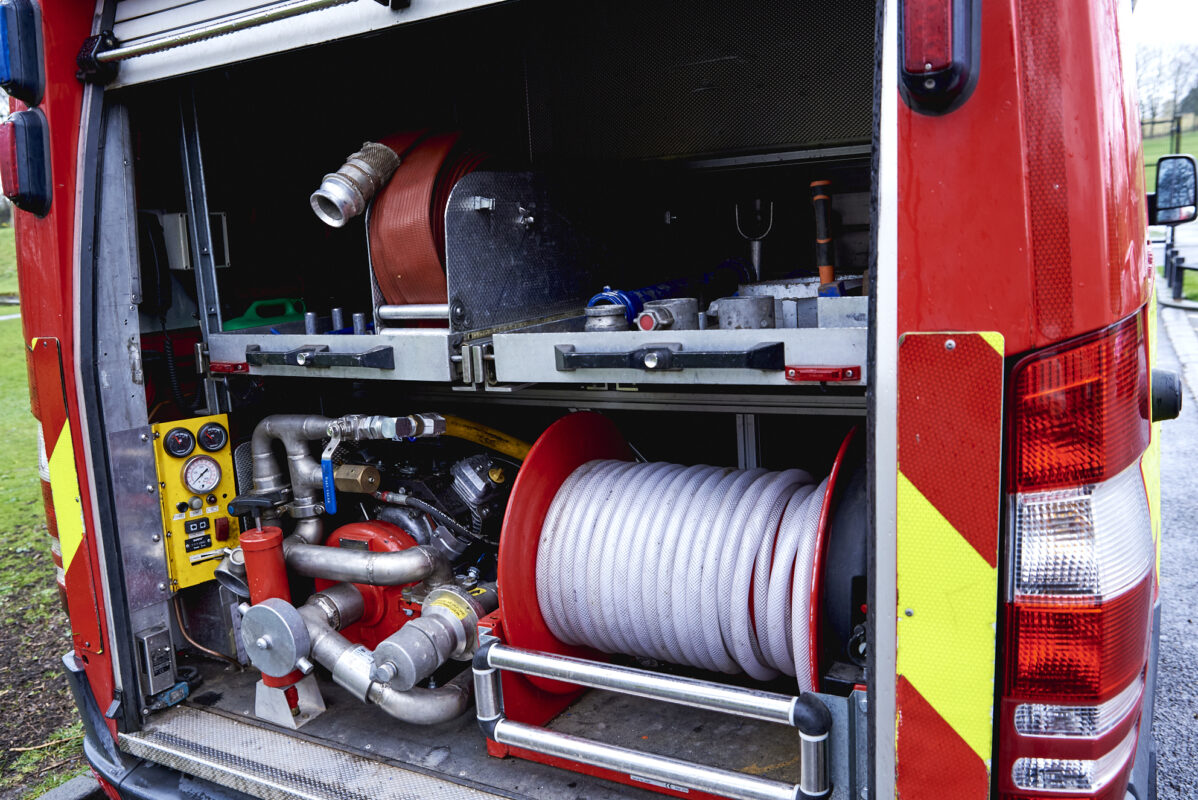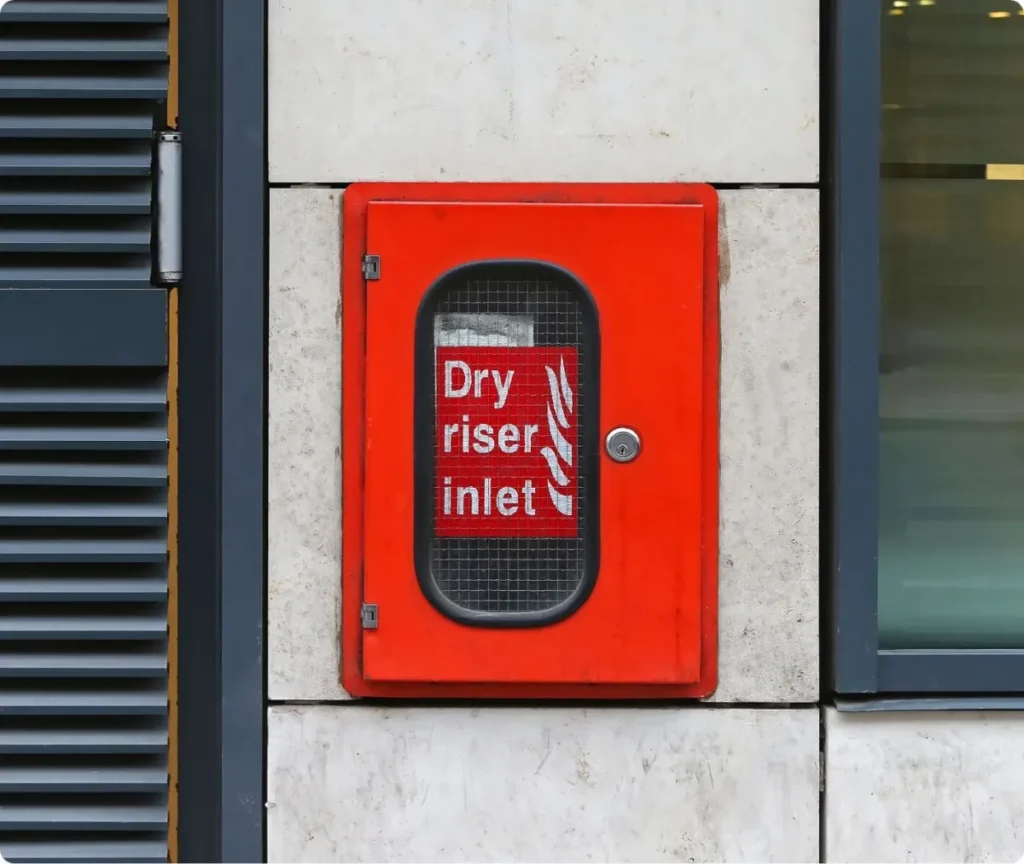Dry Riser
Testing
Request A Service

Over 5 years

Dry Risers Worked With

Wet Risers

Anytime , anywhere

UK Dry Riser Servicing and Testing Company
We offer comprehensive dry riser installation service for inspection, testing, maintenance, and repairs!
To ensure the top-quality of your equipment at any given time, we strictly follow the BS9990 and BS9251 standards. This way your equipment is fully functional and easily accessible for firefighters in the event of a fire. Not only does this make the job of the firefighters easier and allows them to act faster, but it can also save lives.
Our team of professionals has years of experience in installing, maintaining, testing and repairing dry risers. For scheduled testings, our team will always bring spare inventory to be prepared and ready to perform any required on-spot fixes. Instead of having to schedule a second appointment for repairs, we can fix it immediately on location, which will save you time and money.
For dry riser testing, we offer 6-monthly inspections and annual testings required by the British Standard BS9990:15, the latest version of the British Standard BS9990, anywhere in the UK.
We have contracts with FM companies, Block management, and individual property owners throughout the country.
To schedule an appointment for a dry riser inspection or testing, simply call us under 0800 010 6137 or email us at info@dryrisersolutions.co.uk.
A representative will be in contact with you soon!
How often is testing required on a dry riser?
As the BS9990:15 states, visual inspection of dry risers is mandatory every 6 months and more detailed testing of the dry riser’s functionality is mandatory once a year.


Why is Dry Riser Testing so important?
Regular dry riser inspections and testings are essential to ensure functional and easily accessible equipment at all times. The purpose of a dry riser system is to provide fast equipment to firefighters, so they don’t have to drag their equipment several levels up a building in the event of a fire. This saves time and can turn into a major requirement to save lives.
As fires are usually unexpected, it is important to be prepared at all times, which requires regular inspections and testings. This way, potential issues can be fixed fast and the dry riser system ensures the ability of fast action in case of a fire.
Who is responsible for Dry Riser Testing?


Dry Riser Maintenance UK
The process of installing a dry riser within your business requires a high level of knowledge of construction. We are a full dry riser installation accredited. However, we can install a dry riser in your premises and can make the difference between a major problem arising from a broken or faulty dry riser and a minor inconvenience.
Dry risers are a type of vertical piping designed to supply water directly to various levels of a house, usually used by firefighters in case of a fire break out. They are normally connected directly to the main water supply pipes of the building where they are connected to the floor joists. Some people install their dry risers over their existing main supply lines and water them individually. However, this method is more expensive than doing it via a dedicated dry riser maintenance service.
The process of installing a dry riser within your business requires a high level of knowledge of construction. We are a full dry riser installation accredited. However, we can install a dry riser in your premises and can make the difference between a major problem arising from a broken or faulty dry riser and a minor inconvenience.
Dry risers are a type of vertical piping designed to supply water directly to various levels of a house, usually used by firefighters in case of a fire break out. They are normally connected directly to the main water supply pipes of the building where they are connected to the floor joists. Some people install their dry risers over their existing main supply lines and water them individually. However, this method is more expensive than doing it via a dedicated dry riser maintenance service.
There are two main types of dry risers: the vertical pipes that run horizontally and the lateral pipes which run vertically. In both cases, the dry risers are placed above the floor joists so that the water is distributed down into the floor joists as well. When installing these types of systems, many people overlook the need for the riser maintenance. In addition to the horizontal and vertical risers, there are also other types of dry risers such as the lateral pipes. Each has their own set of issues which require their own level of maintenance.
Vertical risers are easier to install compared to the lateral pipes. These systems require less work due to the fact that they are already built. This means that they are less susceptible to damage. However, there is still a certain degree of maintenance required for these systems. Here’s what you need to do when you want to perform maintenance on your vertical riser:
First, you need to check that the dry risers have been connected properly. Many of these systems are self-sealing and they require no external sealing. You don’t want to be caught with a leaky pipe while you are trying to do this repair.
Next, you need to disconnect any valves attached to the risers. Make sure that they have been disconnected properly. This may require you to use plumbers tape.
Once you have disconnected all valves and pipes from the risers, you need to clean up any debris that might be present in the pipe. This includes tree roots, logs and other debris. Once you’ve cleaned it, you will need to apply a coating of water-repellent paint over the surface of the pipe to prevent water from leaking back through the pipe. You will also want to check to see that the pipe is free from any splinters or broken pieces that could cause water leakage.
Finally, you need to lubricate the inside of the pipe with oil. It’s best to use a spray lubricant rather than a liquid one because it’s easier to work on. You can purchase oil in any hardware store near you or even use a pump sprayer. It’s important to keep a close eye on the pipe after lubrication and check if it’s moving in an appropriate direction. If it is moving too slowly, you need to add some more oil or lubricant and try again.
This type of maintenance is often very easy and you can perform this task in just a small amount of time. In most cases, you should never have to call a plumber to get it done since you have access to the proper tools and products.
Wet riser maintenance is a bit more complex since you need to make sure that no water gets into the pipes. To prevent this from happening, you need to use a drain snake to remove excess water that has seeped through the pipe.
When you are finished with the process, you should use caulk to seal the pipe so that no more leaks will happen. and you should allow the pipe to dry completely dry before resealing it. After you’ve completed this step, you should check the pipe for leaks and reattach the valve and plugging.

What is BS9990:15?
The British Standard BS9990:15 is the latest version of the BS9990, published in 2015.
It provides requirements for dry riser testing, maintenance, and servicing.
Moreover, it requires a mandatory 6-monthly visual inspection and annual physical testing of the dry riser system along with revision and documentation of the process.
Our team strictly follows the BS9990:15 recommendations and requirements to ensure the full functionality and safety of the dry riser system.
One of the main requirements of BS9990:15 is an annual pressure testing to 12Bar.
To get a more detailed overview of the new BS9990:15 regulations, click here!
What does the 6-monthly inspection include?
As the British Standard BS9990 requires, a visual inspection of a dry riser system is required every 6 months and a physical testing every 12 months.
During the 6-monthly inspection, our professionals will take a look at the dry riser system to make sure that there are no visual signs of damage. If we find any damaged or missing parts, we will document this and repair or replace the damaged or missing parts.


What does annual testing of dry risers include?
In comparison to a quick and purely visual 6-month inspection, the annual testing of a dry riser system is more in-depth and includes a physical test of the dry riser installation.
First, an air pressure test is carried out to avoid flooding in case the system has any leaks. During a following hydraulic pressure test, a fire service approved hose and water pump is filled with water to a pressure of 12 bar for at least 15 minutes. This will indicate whether the system has any leaks that need to be repaired and is one of the main requirements by BS9990:2015.
On top of this, our experts will check the dry riser cabinets and signage and carry out expansive testing of all valves, outlet valves, washers, seals, and inlets.
After all, tests are being completed and potential issues are fixed, the dry riser system will be drained and outlet valves, as well as the inlet breaching cabinet, will be closed.
In total, the testing will take between one and two hours.
Our team will then provide you with a certificate, stating the date of testing along with a confirmation that the equipment meets all the requirements of the BS9990:2015.
Why test with Dryrisersolutions?
If a dry riser testing in your building is due, we can help you by providing fast service from our team of professionals. No matter where you are located in the UK, we will bring local experts to you.
Our engineering professionals have years of experience in installing, testing, maintaining, and repairing dry risers.
Additionally, to the testing, they will bring the necessary spare inventory with them, which allows them to fix any potential issues they find during the tests and replace faulty parts immediately. This will save you time and money for a second appointment.
Most importantly, we work strictly according to the British Standard BS9990:15 and all are parts used in designing comply with the British Standard BS5041.
To book our fast and efficient dry riser testing service, please contact us!
We are open Mondays – Saturday from 8am to 6pm and happy to make an appointment for your dry riser testing!

Additional Services

Dry Riser Installation

Dry Riser Testing

Dry Riser Regualations

Wet Riser

Wet Riser Systems

Fire Sprinkler Servicing

Fire Hydrant Servicing

Fire Hyrdrant Flow Testing

BS9990

BS9251

Fire Safety Training

HMO Fire Assesment



